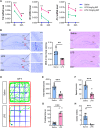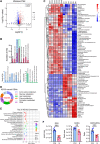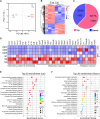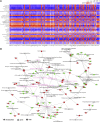Integrated transcriptomics and metabolomics analysis of the hippocampus reveals altered neuroinflammation, downregulated metabolism and synapse in sepsis-associated encephalopathy
- PMID: 36147346
- PMCID: PMC9486403
- DOI: 10.3389/fphar.2022.1004745
Integrated transcriptomics and metabolomics analysis of the hippocampus reveals altered neuroinflammation, downregulated metabolism and synapse in sepsis-associated encephalopathy
Abstract
Sepsis-associated encephalopathy (SAE) is an intricated complication of sepsis that brings abnormal emotional and memory dysfunction and increases patients' mortality. Patients' alterations and abnormal function seen in SAE occur in the hippocampus, the primary brain region responsible for memory and emotional control, but the underlying pathophysiological mechanisms remain unclear. In the current study, we employed an integrative analysis combining the RNA-seq-based transcriptomics and liquid chromatography/mass spectrometry (LC-MS)-based metabolomics to comprehensively obtain the enriched genes and metabolites and their core network pathways in the endotoxin (LPS)-injected SAE mice model. As a result, SAE mice exhibited behavioral changes, and their hippocampus showed upregulated inflammatory cytokines and morphological alterations. The omics analysis identified 81 differentially expressed metabolites (variable importance in projection [VIP] > 1 and p < 0.05) and 1747 differentially expressed genes (Foldchange >2 and p < 0.05) were detected in SAE-grouped hippocampus. Moreover, 31 compounds and 100 potential target genes were employed for the Kyoto Encyclopedia of Genes and Genomes (KEGG) Markup Language (KGML) network analysis to explore the core signaling pathways for the progression of SAE. The integrative pathway analysis showed that various dysregulated metabolism pathways, including lipids metabolism, amino acids, glucose and nucleotides, inflammation-related pathways, and deregulated synapses, were tightly associated with hippocampus dysfunction at early SAE. These findings provide a landscape for understanding the pathophysiological mechanisms of the hippocampus in the progression of SAE and pave the way to identify therapeutic targets in future studies.
Keywords: RNA sequencing; integrative analysis; metabolomics; multi-omics analysis; neuroinflammation; sepsis-associated encephalopathy.
Copyright © 2022 Xu, Li, Zhang, Le, Huang, Fu, Croppi, Qian, Zhang, Zhang and Lu.
Conflict of interest statement
Author GC is employed by Connect Biopharma Ltd. The remaining authors declare that the research was conducted in the absence of any commercial or financial relationships that could be construed as a potential conflict of interest.
Figures






Similar articles
-
Multi-omics analysis reveals neuroinflammation, activated glial signaling, and dysregulated synaptic signaling and metabolism in the hippocampus of aged mice.Front Aging Neurosci. 2022 Nov 3;14:964429. doi: 10.3389/fnagi.2022.964429. eCollection 2022. Front Aging Neurosci. 2022. PMID: 36408109 Free PMC article.
-
Genetic differences in hippocampus of mice susceptible to sepsis-associated encephalopathy.Zhong Nan Da Xue Xue Bao Yi Xue Ban. 2024 Nov 28;49(11):1777-1789. doi: 10.11817/j.issn.1672-7347.2024.240045. Zhong Nan Da Xue Xue Bao Yi Xue Ban. 2024. PMID: 40177761 Free PMC article. Chinese, English.
-
Integrative Analysis of DNA Methylation and Gene Expression Reveals Key Molecular Signatures in Spatial Memory Impairment of Sepsis-Associated Encephalopathy.J Neurochem. 2025 Jun;169(6):e70120. doi: 10.1111/jnc.70120. J Neurochem. 2025. PMID: 40501217
-
The biological alterations of synapse/synapse formation in sepsis-associated encephalopathy.Front Synaptic Neurosci. 2022 Dec 2;14:1054605. doi: 10.3389/fnsyn.2022.1054605. eCollection 2022. Front Synaptic Neurosci. 2022. PMID: 36530954 Free PMC article. Review.
-
Neuroanatomy and Physiology of Brain Dysfunction in Sepsis.Clin Chest Med. 2016 Jun;37(2):333-45. doi: 10.1016/j.ccm.2016.01.013. Clin Chest Med. 2016. PMID: 27229649 Review.
Cited by
-
GAS6/AXL signaling promotes M2 microglia efferocytosis to alleviate neuroinflammation in sepsis-associated encephalopathy.Cell Death Discov. 2025 Jun 6;11(1):268. doi: 10.1038/s41420-025-02507-8. Cell Death Discov. 2025. PMID: 40480981 Free PMC article.
-
MSC-derived exosomal miR-140-3p improves cognitive dysfunction in sepsis-associated encephalopathy by HMGB1 and S-lactoylglutathione metabolism.Commun Biol. 2024 May 11;7(1):562. doi: 10.1038/s42003-024-06236-z. Commun Biol. 2024. PMID: 38734709 Free PMC article.
-
The progress of the microbe-gut-brain axis in sepsis-associated encephalopathy.Front Cell Infect Microbiol. 2025 May 13;15:1587463. doi: 10.3389/fcimb.2025.1587463. eCollection 2025. Front Cell Infect Microbiol. 2025. PMID: 40433666 Free PMC article. Review.
-
Exploring and Validating the Mechanism of Ulinastatin in the Treatment of Sepsis-Associated Encephalopathy Based on Transcriptome Sequencing.J Inflamm Res. 2024 Nov 14;17:8753-8773. doi: 10.2147/JIR.S488400. eCollection 2024. J Inflamm Res. 2024. PMID: 39564549 Free PMC article.
-
Multi-omics analysis reveals neuroinflammation, activated glial signaling, and dysregulated synaptic signaling and metabolism in the hippocampus of aged mice.Front Aging Neurosci. 2022 Nov 3;14:964429. doi: 10.3389/fnagi.2022.964429. eCollection 2022. Front Aging Neurosci. 2022. PMID: 36408109 Free PMC article.
References
-
- Anders S., Huber W. (2012). Differential expression of RNA-Seq data at the gene level - the DESeq package[J]. Heidelberg,Germany: European Molecular Biology Laboratory (EMBL).
LinkOut - more resources
Full Text Sources
Research Materials

